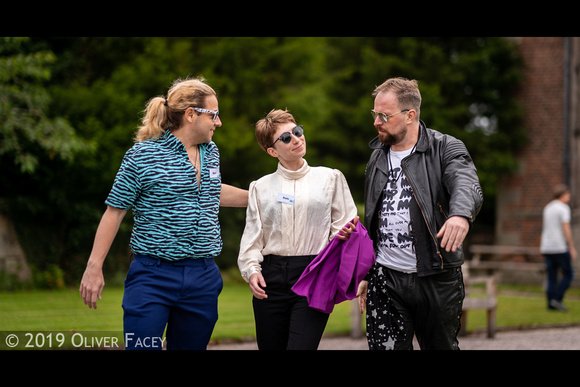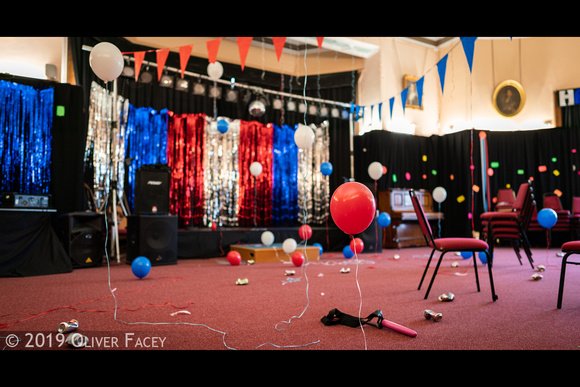Nordic-style live-action roleplay with Arianna Gass
By Arianna Gass
This past summer I used my Arts, Science, and Culture Initiative Fellowship funding to travel to the West-Midlands of England where I played Just a Little Lovin’ (JALL). JALL is a Nordic-style live-action roleplay (larp) game designed by Tor Kjetil Edland and Hanne Grasmo in which participants reinhabited the 1980s AIDS crisis in New York City. Nordic larp is a form of collaborative storytelling that feels like improvisatory theater, but without an audience—or like the best game of make-believe you ever played as a child. It differs from its cousins, tabletop role-playing (think Dungeons and Dragons) and American boffer-style larp (people running around the woods with foam swords) in that Nordic larp doesn’t require dice and it doesn’t have to center around combat. It features an immersive or 360-degree style of gameplay: once gameplay starts, it doesn’t stop for meals, and sometimes, even for sleep.
For JALL, 80 people from around the world convened at Ingestre Hall, an English country house flanked by idyllic gardens and sheep grazing in the fields beyond. Already assigned characters and relationships, we came bearing costumes and props: everything we thought we would need to tell a story about love, fear, and friendship during the AIDS crisis in New York City. We spend most of the first day in safety workshops, where we learn how to verbally and non-verbally negotiate the terms of our play. We also learn the play techniques that make JALL one of the most frequently run Nordic larps for its bold take on intimacy and history. These techniques include the “phallus technique,” which is used to simulate sex in-game, and “black box,” which allows players to run scenes outside of game’s timeline. You can’t tell the story of the AIDs crisis without sex, and in JALL, all sex requires players (not characters) to: explicitly negotiate physical and emotional boundaries before playing the scene; simulate sex with a phallus in a metaphorical or literal manner; and conclude sex scenes with monologues that describe how the scene influences or changes their characters.
The game begins. It’s 1982 and we aren’t at Ingestre Hall, we’re at a rented venue where wealthy Terrence Thurlow (or Mr. T, as he is known in the “scene”) throws his annual Fourth of July party, which also happens to be the site of a yearly retreat for a group of cancer survivors who call themselves the Saratoga Pact. My name is Rain—I am in a band called Urban Renaissance with my pop-obsessed little brother Skye and Simon, my ex-ish lover with a destructive streak. We’re set to perform in Mr. T’s cabaret tonight—if I can keep Skye and Simon out of trouble for long enough. I’m also going to debut some new poetry for famous Village poet Abner and his elite literary circle (and hopefully pick up a cute boy I met at a café).
But 1982 doesn’t go as planned. The cute boy is taken. Though my poetry goes over well, especially with Nick, a reporter for The Voice, the Abner literati reject me after Urban Renaissance plays Skye’s raunchy pop song. Nick calls me a sellout. Simon hooks up with every other man at the party. We play a good set, but that success is eclipsed by a larger artistic failure. Sellout. I hook up with some guy from the Saratoga pact who only wears white linen—a guru who gives me weed and a sad blowjob in the woods. I go to sleep knowing the only person at this party I want to be with is Simon.
The next day, death comes for Rain. Literally. I, Arianna/Rain, am escorted out of Ingestre Hall by an organizer who is playing the character of Death. She leads me to Rain’s coffin in the fields beyond the mansion. I get in. The coffin is closed. When it opens, someone is sitting next to me singing O’seh Shalom. Nick is sobbing, apologizing, holding me. Skye is crying. I fear that Simon won’t come to see me. The first act of the game ends with the last refrain of Dusty Springfield’s Just a Little Lovin’.
Each day of the game takes place at the same party in 1983, and again in 1984. Each year there are more deaths and infections—people get HIV, remission ends, they die of AIDs, they die of cancer. The party gets new guests, including my second character, Connor, a nurse at Mount Sinai hospital who primarily cares for patients with AIDS. Over the next two days, our characters attend memorials, we write newspapers, we get angry because we feel ignored and abandoned, we learn about transmission, contraction. We fall in love again and again and again.
As a researcher, I study embodiment, sexuality, and gender in play contexts. My objects of inquiry are usually interactive theater, board and tabletop games, and video games; things you can’t know until you are a player yourself. Nordic larp has a huge financial barrier to entry that is unlike most other game or theatrical experiences. Through ASCI, I received the funding I needed to have a truly transformational personal experience as well as an important and formative research experience. Beyond being interesting material through which to think about what happens to our bodies when we enter the lusory attitude that facilitates game play, JALL was an empathic experience, an experiment with emotional highs and lows that revivified a queer history so often silenced and erased.
Not only am I grateful to ASCI for giving me the means to explore this niche theatrical/game genre, I am exceedingly grateful to my co-players, the many organizers of JALL, and the game designers that have, for the past eight years, kept this crucial story of queer survival alive and well in our world.
Images by Oliver Facey.
Captions:
1. Urban Renaissance plays a hit song at Mr. T’s party.
2. Skye (L), Rain (C), and Simon (R), aka “The Boys in the Band.”
3. Rain at the beginning of the first act: July 4th, 1982.
4. The morning after, just before Death’s arrival.




